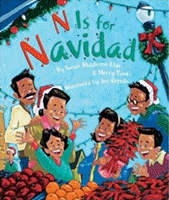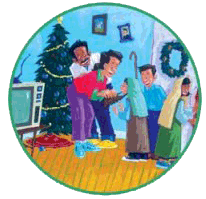Reviews
Kirkus
A lively introduction to Latino Christmas traditions follows an alphabetical structure as a way to introduce key Spanish terms and explain holiday customs and activities. The highlighted words include the Spanish words for decorations, food, family members, key characters in the Nativity store and terms relating to church attendance. Additional days of celebration, such as Las Posadas and Three Kings Day, are also included. The authors skillfully pack their short, rhyming text with a rather amazing amount of information, while still making the text peppy and interesting. Cepeda fills his bouyant painting with fruits and flowers in brilliant colors, smiling people enjoying the holiday treats and backgrounds in bright greens and blues creating a cheerful mood. The illustrations show one extended family enjoying the holiday in a chronological progression, from hanging the first decorations at the beginning of the season to setting out their zapatos (shoes) fro Three kings Day. An author's note provides further information (noting that most of the customs included are Mexican in origin). And a glossary gives pronunciations for the Spanish words and complete definitions.
Booklist
With bright oil-and-acrylic paintings, this lively alphabet rhyme depicts a smiling extended Mexican family preparing for and celebrating the Christmas season from A is for angel, hung high by Papá to Z is for zapatos, so we'll get our wish. A pronunciation guide for the Spanish words translated in the text appears in a spacious two-page glossary at the back, and a note explains that some Latinos begin celebrating on December 16 and continue thorugh January 6. The exuberant, rainbow-colored paintings show children and adults cooking, playing, and acting out the travelers' search for hogar (home) as they go from house to house and are told No room at the inn. One of the last double-page spreads shows two rows of zapatos (shoes) which have been set out to await the wise men (who) come through with presents and candy and blessings for you. Many little ones will enjoy the picture of a loving family celebrating together. --- Hazel Rochman.
The Horn Book
C is for campanas,/ at the church down the street. / CH is for chiles, to string, not to eat! This rhyming alphabet book depicts the seasonal festivities and customs celebrated by many Latino families, from the preparations for the nine nights of Las Posadas that lead up to Christmas through Three Kings Day in January. An appended authors' note provides additional information, as does the helpful combined glossary/pronunciation guide. While Cepeda's illustrations feature happy people with such gleaming smiles they could be advertising teeth whitener, the vibrantly colored oil painting vividly capture the scenes of holiday cheer. JMB.
School Library Journal
Cepeda's lively paintings take a colorful, dynamic look at a warm Latino neighborhood celebration of the holiday season. The alphabet action is a little uneven, with the emphasis on simple Spanish words that are easily understood with the illustration and/or supporting text. The word choices are weakened with a jump to English. W is for wise men/ tres reyes, three kings and X is for excelente / the feeling He brings! ll and rr are bonus combinations to expand the reach of the alphabet. This book has potential to provide a springboard for discussion of holiday traditions while keeping children entertained visually. A glossary with pronunciation guide is attached. Anne Connor, Los Angles Public Library.
Contra Costa Times
With a light touch and sure hands, Banks and Elya have created a merry Christmas celebration, Latina style, uysing the alphabet to introduce readers to the traditional customs of a Mexican Navidad. Cepeda's oil and acrylic cartoonlike illustrations accent the rhyming couplets. Joanna Kraus.
San Francisco Chronicle
East Bay authors Susan Middleton Elya and Merry Banks focus on a Latino-style Christmas in the bilingual alphabet-motif book N is for Navidad, cheerily illustrated by Joe Cepeda. B is for buñuelos , fried by Mamá. C is for campanas that ring at the church, and so on. We see a happy family throughout the Christmas season, starting Dec. 16 at Las Posadas, going to la misa ( Mass) at la iglesia on Christmas, having tamales on New Year's Eve and setting out zapatos (shoes) to get candy from tres reyes on Three Kings' Day on Jan. 6th .
Parenting on the Peninsula, Children’s Book and Music Reviews
"Why not add some Latino zest to your holiday celebrations? N is for Navidad does just that…All the above can be served up with hot cocoa and cookies for a toasty holiday treat. Co-authors Susan Middleton Elya and Merry Banks have teamed up with acclaimed illustrator Joe Cepeda to create N is for Navidad, a very special alphabet book with a Latin beat. A lively, rhyming text introduces a new Spanish word, sometimes two, for each alphabet letter: "A is for angel, hung by Papá/ B is for buñuelos, fried by Mamá" and "V is for ventana. We look to the sky/ and pick out the star that the kings traveled by."The rich array of customs and traditions are primarily from Mexican Catholic culture and from Spain. Three Kings Day on January 6 (tres reyes), the lighting of luminarias (L is for luminarias. Hurray!/ They’re paper-bagged candles that light up the way.), and feasting on delicious tamales are but a few of the warm customs brought to life in this delightful and informative picture book. Cepeda’s vivid illustrations are full of humor and affection. Executed in oil and acrylic on illustrator board, the detailed paintings will entice young readers.
An authors’ note includes an excellent glossary for over forty Spanish words and terms along with fascinating information about the various customs described in the book. For example, did you know that twelve grapes are traditionally eaten in the very first minute after midnight on New Year’s Eve? It’s a custom that comes from Spain to bring good luck in the New Year. And, instead of stockings, Latino children set out their shoes the night before Three Kings Day, hoping to receive gifts from the three wise men. But their shoes are not empty; they are stuffed with grass (yerba) for the kings’ camels! N is for Navidad is enriching for the whole family.
(Chronicle Books, $14.95, age 4-8. December 2010)" -- Caryn Huberman Yacowitz |







